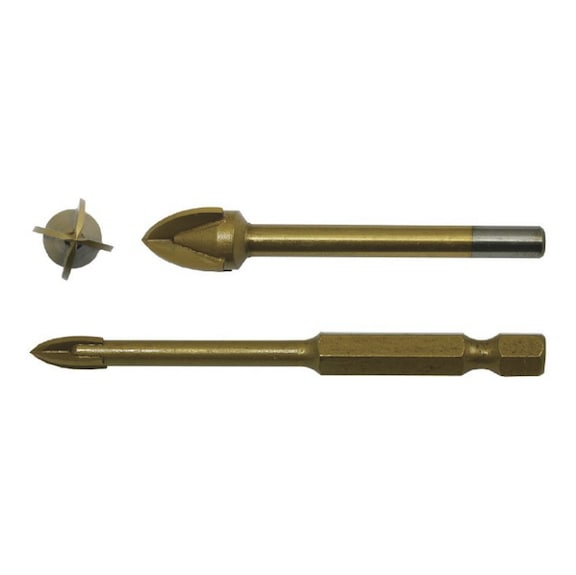For detailed information, other images and documents, please select individual articles from the following table.
TIN-coated tile drill
Designed for precise drilling of holes in glass, tiles, ceramics, mirrors and porcelain
Register now and access more than 125,000 products
Variants
Register now and access more than 125,000 products
Special repositioned carbide slices
- TIN coated for longer service life
- Precision drilling without chips and material breakage
- Sharp tip for easy drilling
Hexagonal shank from 3mm to 10mm diameter
- No slipping in the chuck
- Optimal torque transfer
Cylindrical shank from 12mm to 25mm diameter
- From a diameter of 12mm the cylindrical shank is twisted to 10mm
When drilling, it is necessary to ensure low speed without impact and rinsing the drilled material with water
- Max. speed: Diameter 5 mm (800 rpm), diameter 6 and 8 mm (600 rpm), diameter 10 and 12 mm (400 rpm), diameter 14 mm (200 rpm)
- Not suitable for impact drilling. For rotary drilling only!
- Low pressure: 35-45 kg
- If the recommended drilling speed and optimum pressure are maintained and you still hear no screeching sound, the drill has reached the end of its service life.
- Avoid excessive pressure on the drill bit if it does not turn → It may break!
- Too low pressure or too high rotation speed→ Shortened drill life!
- Avoid tilting and circular movements during drilling→ Danger of breakage!
- We recommend drilling test holes (ideally in waste material from the tiles to be drilled)
- When using a 14 mm drill bit, it is necessary to pre-drill with another drill bit (8 mm).
Rotary drilling in stoneware tiles, tiles, glass (not safety glass) and porcelain. Ideal for electric and cordless drills.
"1. Start the hole with pinpoint accuracy with the application of light pressure
2. Switch on the drill
3. Apply full pressure - a screeching sound must be audible
4. Once the drill bit is completely through the tile, reduce the pressure”
Select RAL-colour code
!! NOTE: On-screen visualisation of the colour differs from real colour shade!!



